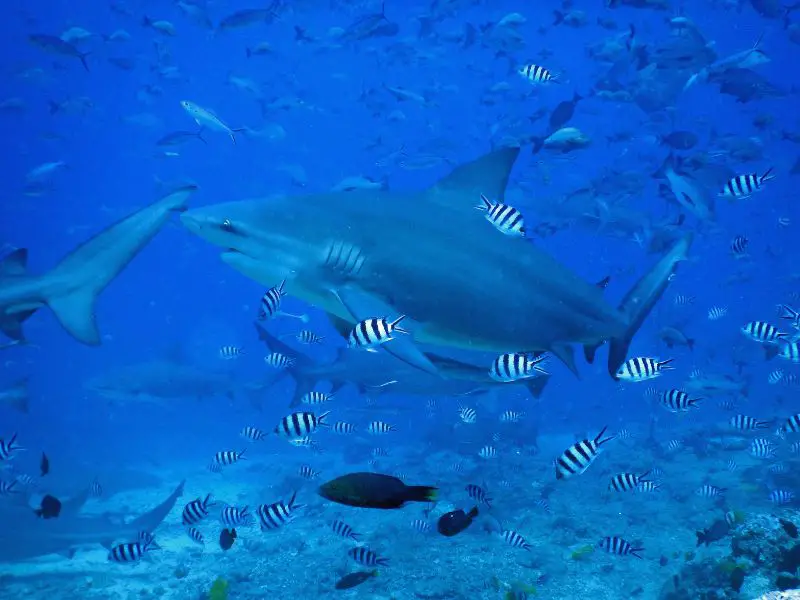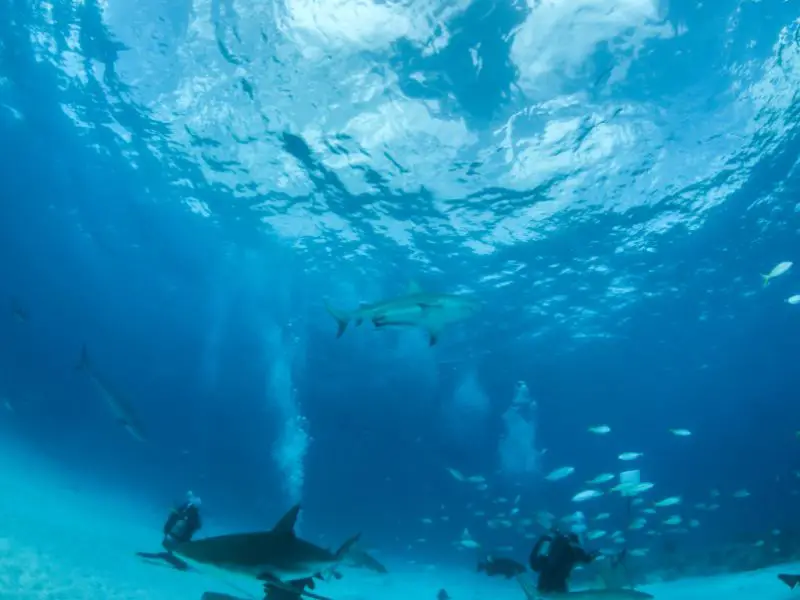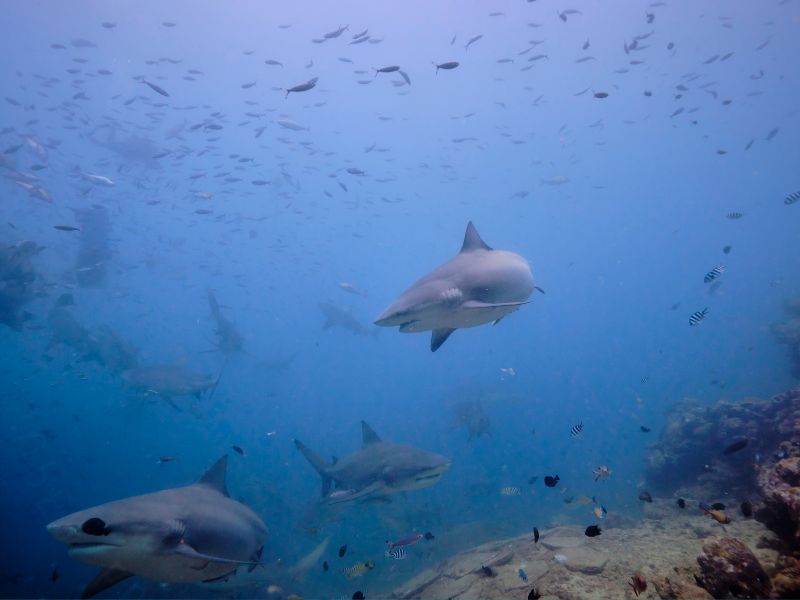Bull sharks (Carcharhinus leucas) captivate marine enthusiasts and scientists with their alluring combination of adaptation and aggression. The question “Where do bull sharks live?” is frequently asked. In this essay, we set out on an enlightening trip exploring the ecological preferences and behavioral habits of these fearsome animals, highlighting their astonishing potential to thrive in both freshwater and saltwater environments.

Habitat Diversity of Bull Sharks
They astound with their adaptability, transcending various aquatic realms and distinguishing themselves from their shark counterparts. While numerous sharks confine themselves to the briny deep, they thrive in freshwater and saltwater ecosystems, traversing many coastal regions, rivers, and even lakes.
Saltwater Habitats
The Coastal Zones
The coastal zones serve as common haunts for bull sharks, patrolling the nearshore waters with their imposing presence. These areas offer a bountiful array of sustenance, including fish, rays, and other marine creatures. The temperate waters and the availability of prey render coastal zones an idyllic hunting ground for these apex predators.
Estuaries and River Mouths
Estuaries and river mouths beckon bull sharks, enticing them into these transitional domains where freshwater merges with the vast ocean. Within these ethereal zones, they embark on exploratory ventures, traversing the realms of both saline and freshwater environments. Estuaries serve as vital sanctuaries for young bull sharks, providing them with protection and abundant nourishment.
Related: Do Sharks Eat at Night?
Freshwater Habitats
Rivers and Lakes
An awe-inspiring attribute of bull sharks lies in their adeptness at navigating freshwater habitats. With unrivaled prowess, they voyage upstream in rivers, venturing even into expansive inland lakes. Documented across a plethora of freshwater systems worldwide, they exhibit astonishing adaptability to diverse water conditions.
The Astonishing Case of Bull Sharks in the Amazon
The Amazon River, an epitome of vastness and ecological diversity, embraces a unique population of them. These extraordinary creatures have successfully acclimatized to the freshwater environment, defying conventional notions of shark habitat preferences. Their discovery, hundreds of miles away from the ocean, stands as a testament to their unrivaled adaptability.

Factors Influencing Bull Sharks’ Habitat Selection
Several factors exert influence over the habitat preferences of bull sharks, providing profound insights into their distribution and behavior:
Salinity Tolerance
They exhibit an astonishing capacity to withstand varying salinity levels, enabling them to flourish in saline and freshwater realms. Their biological adaptations, including osmoregulation, facilitate the regulation of internal salt concentration in diverse environments.
Temperature Predilections
Warm waters within the range of 22 to 28 degrees Celsius (72 to 82 degrees Fahrenheit) form the preferred temperature range for bull sharks. These optimal conditions are often found in coastal regions and estuaries, frequently serving as their dwelling grounds.
Related: Do Sharks Make Sounds?
Prey Abundance
The availability of prey plays a pivotal role in determining the presence of bull sharks. These opportunistic predators feast upon an extensive range of marine and freshwater species. Abundant prey entices bull sharks to specific habitats, ensuring their sustenance, survival, and reproductive success.
Reproduction and Nurseries
They rely on specific habitats for reproduction and the protection of their young. Estuaries and river mouths assume the crucial role of nursery areas, offering a haven where newborn bull sharks can thrive, shielded from larger predators. These habitats provide the requisite resources for their development, preparing them for subsequent migrations to other environments.

Behavioral Adaptations of Bull Sharks
They have honed various behavioral adaptations that bolster their evolutionary triumph:
Feeding Strategies of Bull Sharks
Renowned for their insatiable appetite, they display unparalleled versatility in their choice of prey. Their culinary repertoire encompasses fish, turtles, dolphins, and even other sharks. Opportunistic feeding behavior enables them to adapt to the ever-changing availability of food in disparate habitats.
Migratory Expeditions
They undertake migratory odysseys, venturing both along the coastline and into riverine domains, covering vast distances in pursuit of sustenance, mates, and suitable nurseries. These migratory patterns contribute to the dispersal of the species and foster genetic diversity among diverse populations.
Societal Structure of Bull Sharks
Contrary to a solitary existence, they exhibit social behavior, congregating in small groups or aggregations. These social interactions facilitate cooperation and knowledge transfer, enhancing their collective survival and adaptability.
Related: Do Sharks Eat Pilot Fish?
Conservation Challenges Encountered by Bull Sharks
They confront a myriad of conservation obstacles that imperil their populations and overall welfare. These challenges encompass:
Habitat Loss and Degradation
Human endeavors such as coastal development, pollution, and habitat destruction exert significant influence on the availability and quality of bull shark habitats. The loss of vital habitats has the potential to disrupt their feeding and reproductive patterns, thereby placing their survival at risk.
Overfishing
They are frequently incidentally captured in fishing gear primarily intended for other species. The practice of overfishing can lead to a decrease in their populations, upsetting the equilibrium of marine ecosystems and influencing their overarching ecological function.
Bycatch and Entanglement
They are susceptible to becoming ensnared or ensnared as bycatch in fishing nets and lines. This unintentional entrapment can result in injury or fatality, further exacerbating the decline of their population.
Solutions for the Conservation of Bull Sharks
Concerted efforts are presently underway to tackle the conservation challenges faced by them. The following key solutions have been identified:
Habitat Protection and Restoration
The establishment of marine protected areas and the implementation of habitat restoration initiatives are paramount in safeguarding and enhancing suitable habitats for bull sharks. These measures effectively ensure the availability of essential resources and create secure spaces for breeding and nursery areas.
Implementation of Sustainable Fishing Practices
The adoption of sustainable fishing practices, such as the utilization of selective fishing gear and the reduction of bycatch, can serve to mitigate the inadvertent capture of bull sharks. This approach aims to maintain robust fish populations while minimizing the harm inflicted upon non-target species.
Related: Do Sharks Like Cold Water or Hot Water?
Public Awareness and Education
Raising public awareness about the significance of bull sharks and their ecological role is essential for their conservation. Education campaigns, outreach programs, and community engagement initiatives are instrumental in promoting responsible conduct and fostering support for conservation endeavors.
Collaboration and Scientific Inquiry
Collaborative endeavors involving researchers, conservation organizations, and government agencies assume a vital role in acquiring a more profound comprehension of bull shark populations, their behavior, and their conservation requisites. Research initiatives serve to inform conservation strategies and furnish invaluable data for decision-making processes.
By confronting these conservation challenges head-on and implementing suitable solutions, we can strive toward safeguarding bull sharks, thus ensuring their long-term survival within our oceans and waterways.

Conclusion
In conclusion, bull sharks exhibit remarkable habitat versatility. These predators are known to inhabit both saltwater and freshwater environments with ease. From coastal seas to river estuaries, bull sharks’ adaptability sets them apart. This adaptability highlights their importance in maintaining aquatic ecosystems and underscores the intricate relationships between these apex predators and their surroundings. Understanding their diverse habitat preferences is crucial for their conservation and the overall health of our marine and freshwater environments.
FAQs (Frequently Asked Questions)
No, they possess the unique ability to flourish in both saline and freshwater environments.
They have been known to embark on journeys spanning hundreds of miles upstream in rivers, showcasing their exceptional navigational prowess.
Although they can survive in freshwater, encounters with humans are relatively infrequent. It is prudent to exercise caution when swimming in their habitats.
The large size and specific habitat requirements of bull sharks pose significant challenges to their maintenance in captivity. They are primarily denizens of the wild.
In the event of an encounter with a bull shark, it is advisable to remain composed and avoid sudden movements. Retreating slowly and cautiously, while granting the shark ample space to swim away, is crucial. Respecting their presence within their natural habitat is of utmost importance.
